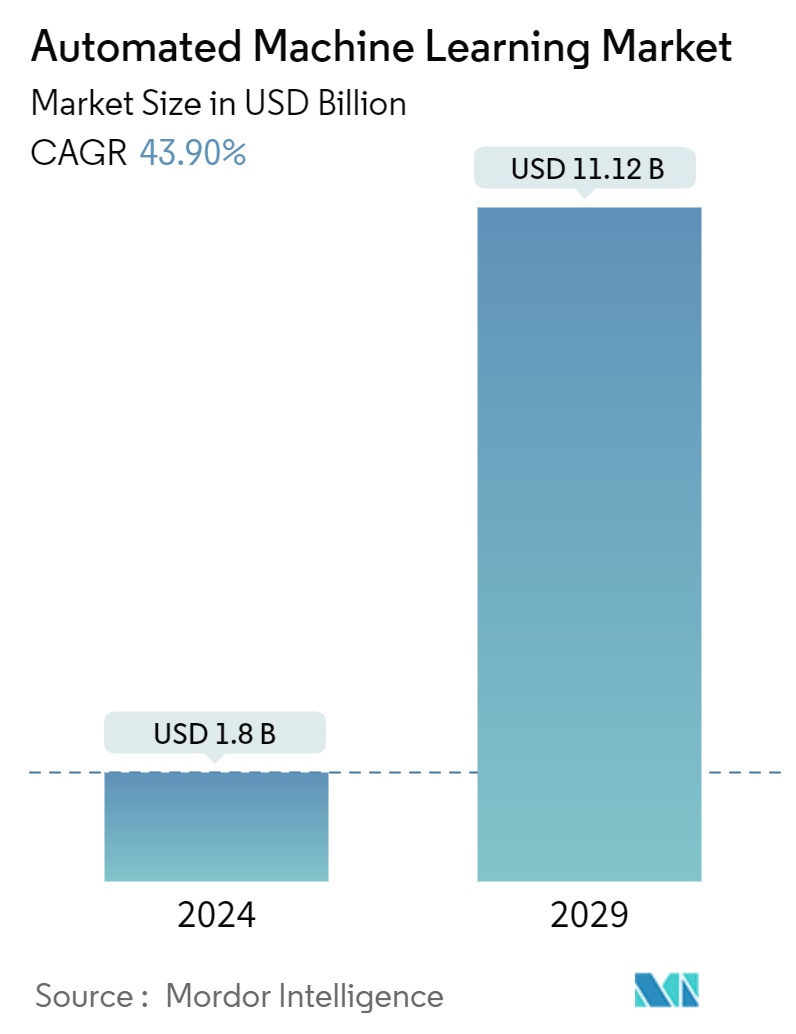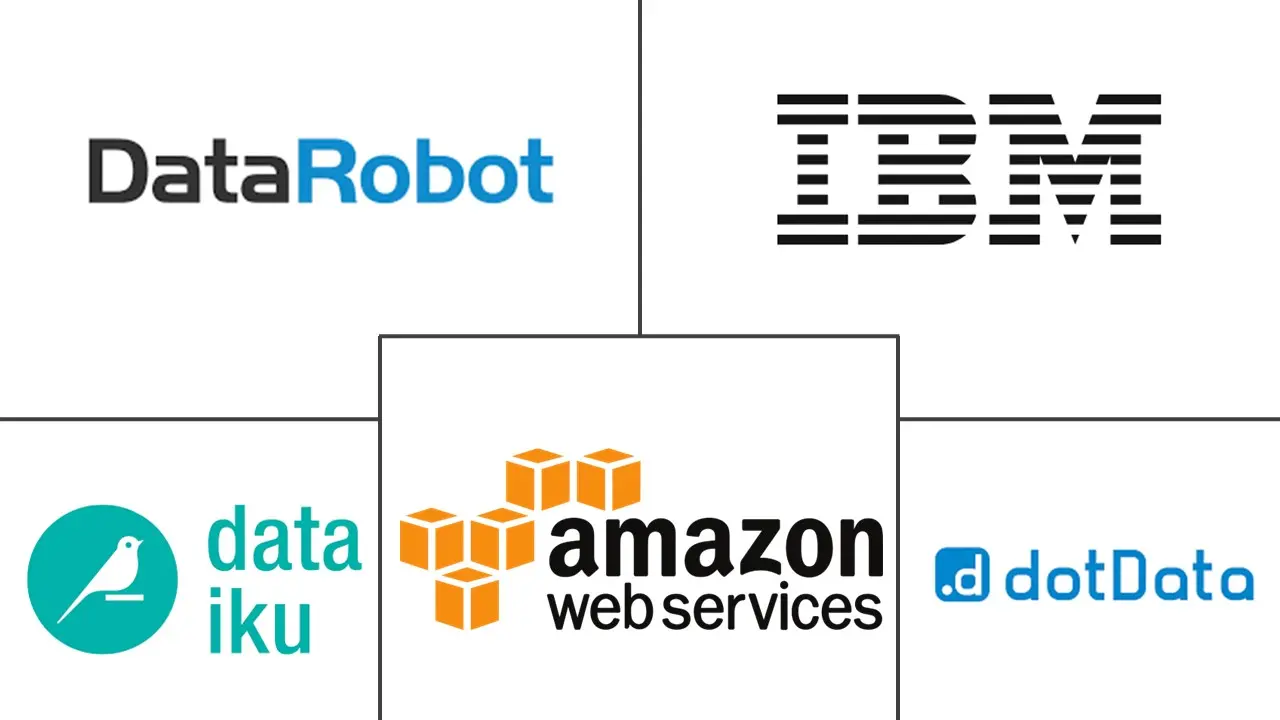Market Size of Automated Machine Learning Industry

| Study Period | 2019 - 2029 |
| Market Size (2024) | USD 1.8 Billion |
| Market Size (2029) | USD 11.12 Billion |
| CAGR (2024 - 2029) | 43.90 % |
| Fastest Growing Market | Asia Pacific |
| Largest Market | North America |
| Market Concentration | Low |
Major Players
*Disclaimer: Major Players sorted in no particular order |
Automated Machine Learning Market Analysis
The Automated Machine Learning Market size is estimated at USD 1.8 billion in 2024, and is expected to reach USD 11.12 billion by 2029, growing at a CAGR of 43.90% during the forecast period (2024-2029).
Machine learning (ML) is a subfield of artificial intelligence (AI) that enables training algorithms to make classifications or predictions through statistical methods, uncovering critical insights within data mining projects. These insights drive decision-making within applications and businesses, ideally impacting key growth metrics. Skilled professionals must develop these solutions since they revolve around algorithms, models, and computational complexity.
- Machine learning (ML) has become an essential component. On the other hand, building high-performance machine-learning applications necessitates highly specialized data scientists and domain experts. Automated machine learning (AutoML) aims to decrease data scientists' needs by allowing domain experts to automatically construct machine learning applications without considerable statistics and machine learning knowledge.
- Due to the increasing adoption of IoT, automation, and cloud-based services, investment in the market has been rising. The solution allows SMEs and enterprises to outsource everything needed to improve data quality, security, safety, and readiness for machine learning and avoid the cost and challenges of employing a data science resource. This service is also supported by Calligo's Data Insights Platform, which is purpose-built for machine learning workloads. For instance, in January 2024, Google Cloud and Hugging Face Announced a Strategic Partnership to Accelerate Generative AI and ML Development. This collaboration will allow developers to utilize Google Cloud's infrastructure for all Hugging Face services, enabling training and serving of Hugging Face models on Google Cloud.
- Some firms have shifted to AutoML to automate internal procedures, particularly the creation of ML models, such as Facebook and Google. Asimo is Facebook's AutoML developer, which automatically generates improved versions of current models. Google also released AutoML tools to automate the process of discovering optimization models and designing machine learning algorithms. Google launched "Cloud AutoML," a product that allows businesses with limited Machine Learning (ML) expertise to build high-quality, custom artificial intelligence (AI) models to enhance Google’s products and services. "Cloud AutoML" lets businesses and developers train custom vision models for their use cases. Such innovations by the companies will drive the market.
- The AutoML market is expected to experience significant growth, driven by rising applications and research in the medical field. As AutoML revolutionizes patient care and medical research, there is a surge in demand for AI-driven solutions tailored to healthcare challenges. AutoML can automate complex machine learning tasks, such as model selection and feature engineering, to streamline the development of predictive models for illness diagnosis, treatment optimization, and drug discovery.
- Machine learning (ML) is increasingly used in many applications, but there needs to be more machine learning experts to support this growth adequately. With automated machine learning (AutoML), the purpose is to make machine learning more accessible. Therefore, experts should be able to deploy more machine learning systems, and less expertise would be required to work with AutoML than when working with ML directly. However, the adoption of technology still needs to be deeper, restraining the market's growth.
- The adoption of AI witnessed an increase post-COVID-19 as companies leveraged intelligent solutions for automating their business processes. This trend is anticipated to continue over the coming years, further driving the adoption of AI in organizational processes.
Automated Machine Learning Industry Segmentation
Automated machine learning or AutoML refers to automating the time-consuming, iterative tasks of machine learning model development. It allows data scientists, developers, and analysts to build large-scale, productive, and efficient ML models while sustaining model quality.
The automated machine learning market is segmented by solution (standalone or on-premise and cloud), automation type (data processing, feature engineering, modeling, and visualization), end user (BFSI, retail and e-commerce, healthcare, manufacturing, and other end users), and geography (North America, Europe, Asia-Pacific, and Rest of the World). The market sizes and forecasts are provided in terms of value (USD) for all the above segments.
| By Solution | |
| Standalone or On-Premise | |
| Cloud |
| By Automation Type | |
| Data Processing | |
| Feature Engineering | |
| Modeling | |
| Visualization |
| By End User | |
| BFSI | |
| Retail and E-Commerce | |
| Healthcare | |
| Manufacturing | |
| Other End Users |
| By Geography | ||||||
| ||||||
| ||||||
| ||||||
| Rest of the World |
Automated Machine Learning Market Size Summary
The automated machine learning market is poised for significant growth, driven by advancements in artificial intelligence and data science. This technology aims to simplify the development of machine learning applications, reducing the need for extensive expertise in statistics and machine learning. As businesses increasingly recognize the potential of automated machine learning, its adoption is expected to rise, facilitated by subscription-based models that offer flexibility and ease of use. Despite its promising capabilities, the market faces challenges due to the still nascent adoption of the technology, which could restrain its growth. The demand for automated machine learning is particularly strong in sectors like banking, financial services, and insurance, where it enhances operational efficiency and customer experience by automating repetitive tasks and enabling rapid data processing.
The United States is anticipated to maintain a substantial share of the automated machine learning market, supported by a robust innovation ecosystem and strategic federal investments in advanced technologies. Similarly, Canada is exploring the potential of artificial intelligence to improve government services, with a focus on ethical and value-driven implementation. The global market is characterized by intense competition, with numerous players striving to expand their customer base and innovate. Notable companies such as Datarobot Inc., Amazon Web Services Inc., and IBM Corporation are leading the charge, introducing new platforms and strategic partnerships to enhance their offerings. As cloud and serverless computing technologies evolve, they are expected to further drive the adoption and development of automated machine learning applications across various industries.
Automated Machine Learning Market Size - Table of Contents
-
1. MARKET DYNAMICS
-
1.1 Market Drivers
-
1.1.1 Increasing Demand for Efficient Fraud Detection Solutions
-
1.1.2 Growing Demand for Intelligent Business Processes
-
-
1.2 Market Restraints
-
1.2.1 Slow Adoption of Automated Machine Learning Tools
-
-
1.3 Industry Value Chain Analysis
-
1.4 Industry Attractiveness - Porter's Five Forces Analysis
-
1.4.1 Threat of New Entrants
-
1.4.2 Bargaining Power of Buyers
-
1.4.3 Bargaining Power of Suppliers
-
1.4.4 Threat of Substitute Products
-
1.4.5 Intensity of Competitive Rivalry
-
-
1.5 Impact of Key Macroeconomic Trends on the Market
-
-
2. MARKET SEGMENTATION
-
2.1 By Solution
-
2.1.1 Standalone or On-Premise
-
2.1.2 Cloud
-
-
2.2 By Automation Type
-
2.2.1 Data Processing
-
2.2.2 Feature Engineering
-
2.2.3 Modeling
-
2.2.4 Visualization
-
-
2.3 By End User
-
2.3.1 BFSI
-
2.3.2 Retail and E-Commerce
-
2.3.3 Healthcare
-
2.3.4 Manufacturing
-
2.3.5 Other End Users
-
-
2.4 By Geography
-
2.4.1 North America
-
2.4.1.1 United States
-
2.4.1.2 Canada
-
-
2.4.2 Europe
-
2.4.2.1 United Kingdom
-
2.4.2.2 Germany
-
2.4.2.3 France
-
2.4.2.4 Rest of Europe
-
-
2.4.3 Asia-Pacific
-
2.4.3.1 China
-
2.4.3.2 Japan
-
2.4.3.3 South Korea
-
2.4.3.4 Rest of Asia-Pacific
-
-
2.4.4 Rest of the World
-
-
Automated Machine Learning Market Size FAQs
How big is the Automated Machine Learning Market?
The Automated Machine Learning Market size is expected to reach USD 1.8 billion in 2024 and grow at a CAGR of 43.90% to reach USD 11.12 billion by 2029.
What is the current Automated Machine Learning Market size?
In 2024, the Automated Machine Learning Market size is expected to reach USD 1.8 billion.

